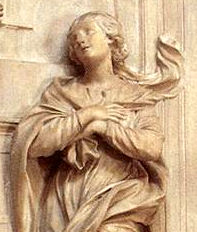Ordinary Time: January 23rd
Saturday of the Second Week of Ordinary Time; Optional Memorials of St. Vincent of Saragossa, deacon & martyr; St. Marianne Cope
Other Commemorations: St. Emerentiana, Virgin and Martyr (RM)
» Enjoy our Liturgical Seasons series of e-books!
St. Vincent of Saragossa, one of the greatest deacons of the Church, suffered martyrdom in Valencia in the persecution under Diocletian. He was born in Huesca, Spain.
Marianne Cope was born on January 23, 1838, in Darmstadt, Germany. In 1862, she entered the Sisters of Saint Francis in Syracuse, New York, after having postponed her entrance nine years in order to fulfill family obligations. She was instrumental in the founding of several schools and hospitals for immigrants. In 1883, she led a group of sisters to the Hawaiian Islands to care for the poor, especially those suffering from leprosy. In 1888 she went to Kalaupapa, Moloka‘i, where she set up a home for girls with leprosy. After the death of Saint Damien de Veuster, she also took over the home he built for boys. She died on August 9, 1918.
According to the 1962 Missal of St. John XXIII of the Roman Rite today is the feast of St. Raymond of Penafort which is now celebrated on January 7 on the General Roman Calendar. It is also the commemoration of St. Emerentiana whose veneration is connected with that of St. Agnes. She was venerated at Rome not far from the Basilica of St. Agnes-Outside-the-Walls on the via Nomentana. The acts of St. Agnes make Emerentiana her foster sister; according to this source, while still a catechumen she was stoned at the tomb of the youthful martyr where she had gone to pray.
St. Vincent of Saragossa
 Vincent of Saragossa was one of the Church's three most illustrious deacons, the other two being Stephen and Lawrence. He is also Spain's most renowned martyr. Ordained deacon by Bishop Valerius of Saragossa, he was taken in chains to Valencia during the Diocletian persecution and put to death. From legend we have the following details of his martyrdom. After brutal scourging in the presence of many witnesses, he was stretched on the rack; but neither torture nor blandishments nor threats could undermine the strength and courage of his faith. Next, he was cast on a heated grating, lacerated with iron hooks, and seared with hot metal plates. Then he was returned to prison, where the floor was heavily strewn with pieces of broken glass. A heavenly brightness flooded the entire dungeon, filling all who saw it with greatest awe.
Vincent of Saragossa was one of the Church's three most illustrious deacons, the other two being Stephen and Lawrence. He is also Spain's most renowned martyr. Ordained deacon by Bishop Valerius of Saragossa, he was taken in chains to Valencia during the Diocletian persecution and put to death. From legend we have the following details of his martyrdom. After brutal scourging in the presence of many witnesses, he was stretched on the rack; but neither torture nor blandishments nor threats could undermine the strength and courage of his faith. Next, he was cast on a heated grating, lacerated with iron hooks, and seared with hot metal plates. Then he was returned to prison, where the floor was heavily strewn with pieces of broken glass. A heavenly brightness flooded the entire dungeon, filling all who saw it with greatest awe.
After this he was placed on a soft bed in the hope that lenient treatment would induce apostasy, since torture had proven ineffective. But strengthened by faith in Christ Jesus and the hope of everlasting life, Vincent maintained an invincible spirit and overcame all efforts, whether by fire, sword, rack, or torture to induce defection. He persevered to the end and gained the heavenly crown of martyrdom.
—The Church's Year of Grace, Pius Parsch
Patronage: vine dressers; vinegar makers; vintners; wine growers; wine makers; Portugal; World Youth Day 2023
Symbols and Representation: Deacon holding a ewer; deacon holding several ewers and a book; deacon with a raven; deceased deacon whose body is being defended by ravens; deacon being torn by hooks; deacon holding a millstone
Highlights and Things to Do:
- Read this account of St. Vincent's martyrdom.
- Read more about St. Vincent:
- Pray to St. Vincent for those ordained deacons in the Church, especially those in your own parish.
- Read Acts of the Apostles 6:1-7 to discover the role of deacons in the early Church.
- The majority of St. Vincent's relics are found in Lisbon Cathedral in Portugal. There are some other relics purported to be in France in the Cathédrale Saint-Benoît de Castres (Church of St. Benedict).
- See the statue of St. Vincent on St. Peter's Basilica Colonnade.
- Cook a Spanish dish in honor of St. Vincent.
St. Marianne Cope
 St. Marianne Cope was born in western Germany in 1838 as Barbara Koob. She entered religious life in Syracuse, New York in 1862. She served as a teacher and principal in several schools in the state and established two of the first hospitals in the central New York area: St. Elizabeth Hospital in Utica and St. Joseph’s Hospital in Syracuse.
St. Marianne Cope was born in western Germany in 1838 as Barbara Koob. She entered religious life in Syracuse, New York in 1862. She served as a teacher and principal in several schools in the state and established two of the first hospitals in the central New York area: St. Elizabeth Hospital in Utica and St. Joseph’s Hospital in Syracuse.
In 1883, Mother Marianne’s community was the only one of fifty to respond positively to an emissary from Hawaii who requested Catholic sisters to provide health care on the Hawaiian Islands, especially to those with leprosy.
Over the next five years, St. Marianne set up a system of long-term education and care for her patients.
She ministered to patients at Kalaupapa on the island of Molokai. Her time of service overlapped with the last years of St. Damien of Molokai, a priest who served victims of Hansen’s disease and himself died of leprosy.
St. Marianne promised her sisters that none of them would ever contract the disease. To this day, no sister has. Her care earned her the affectionate title “beloved mother of the outcasts.”
She died in 1918 and was beatified on May 14, 2005 and canonized on October 21, 2012, both by Pope Benedict XVI.
"At a time when little could be done for those suffering from this terrible disease, Marianne Cope showed the highest love, courage and enthusiasm," Pope Benedict XVI said in his homily during the Mass for her canonization. "She is a shining and energetic example of the best of the tradition of Catholic nursing sisters and of the spirit of her beloved Saint Francis."
—Excerpted from Catholic News Agency
Highlights and Things to Do:
- Read more about St. Marianne Cope:
- Visit online or in person the Shrine and Museum of St. Marianne Cope located in Syracuse, New York. This houses the majority of her relics, although there are other locations, including the Honolulu Cathedral.
- The National Park Service includes information about St. Marianne and where she and her sisters worked Kalaupapa.
- Watch this YouTube video about St. Marianne Cope.
St. Emerentiana
 St. Emerentiana was a Roman virgin, the foster sister of St. Agnes who died at Rome in the third century. Already as a catechumen she was conspicuous for her faith and love of Christ. One day she boldly upbraided the idolaters for their violent attacks on the Christians. The enraged mob retaliated by pelting her with stones. She died in the Lord praying at the tomb of St. Agnes, baptized in her own blood.
St. Emerentiana was a Roman virgin, the foster sister of St. Agnes who died at Rome in the third century. Already as a catechumen she was conspicuous for her faith and love of Christ. One day she boldly upbraided the idolaters for their violent attacks on the Christians. The enraged mob retaliated by pelting her with stones. She died in the Lord praying at the tomb of St. Agnes, baptized in her own blood.
A church was built over her grave which, according to the Itineraries, was near the church erected over the place of burial of St. Agnes, and somewhat farther from the city wall. In reality Emerentiana was interred in the coemeterium majus located in this vicinity not far from the coemeterium Agnetis.
Patronage: against abdominal pains; against colic; against stomach ache; against digestive disorders
Symbols and Representation: girl with stones in her lap and holding a palm of martyrdom or lily of a holy death; young girl being stoned by a mob near the tomb of Saint Agnes of Rome
Highlights and Things to Do:
- Read more about St. Emerentiana:
- Her relics are located in the Sant'Agnese fuori le mura (Basilica of St. Agnes Outside the Walls). There is newer church dedicated to Emerentiana in Rome.






